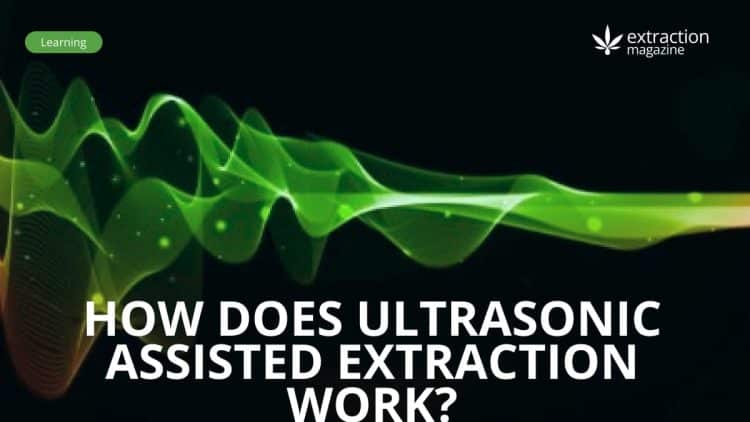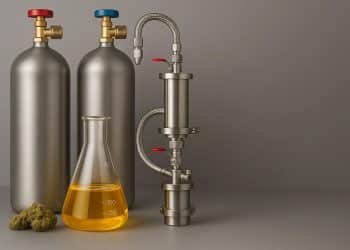Ultrasonic assisted extraction (UAE) was first developed in 2006 to extract sage volatiles from honey. [1] Since then, it has quickly risen in popularity thanks to its numerous advantages over other extraction techniques.
Whether it is used on plant or animal material, UAE continues to prove its value in extracting organic compounds. But what is ultrasonic assisted extraction, and what has led to its meteoric growth across a variety of industries?
The Process of Ultrasonic Assisted Extraction
In any extraction method, the goal can be stated simply: break down the organic material to efficiently extract and isolate the desired compounds in higher quality. In other forms of extraction, this can be achieved through chemical or physical reactions that may employ acidic solvents, aggressive heat, or high pressure to break down the organic matter and improve the overall final yield.
Ultrasonic assisted extraction relies on sound waves to break down the organic matrix by creating the implosion of the cavitation bubbles on the surface of plant tissues. [2] Localized temperature can reach as high as 4500 degrees Celsius and the pressure can get up to 50 megapascals, creating local extreme conditions leading to cell-wall disruption in order to improve target compounds extraction. [3][4]
Ultrasonic assisted extraction can be done in two ways: directly or indirectly.[5]
With direct UAE, the sound waves are applied directly within the solvent using an acoustic tool called a sonotrode.[6] Imagine a probe that is inserted into the solution that aggressively bombards the material with sound throughout the container. Indirect UAE is not applied within the solvent container, but instead the container is immersed in an environment of sound waves. This is often described as a bath, but it is essentially a compartment or chamber that radiates sound throughout the confined space.
This technique has the added advantage of allowing multiple extractions to occur simultaneously if the parameters match based on the organic material. Following the exposure to the sound waves, whether directly or indirectly, there is a final clean up stage that separates any unwanted byproducts from the desired compounds being extracted. [7] This is common with all extraction methods though, as the desired compounds need to be isolated from any other unwanted byproducts.
The Pros and Cons of UAE
Using sound to break down plant material seems revolutionary, and there are several advantages to this extraction method. The first is that this process is significantly faster than other extraction methods. [8] The time required depends on the nature of the plant material, rangin from 20-40 minutes to 10-15 minutes.
This method is also highly efficient. [9] UAE’s energy consumption is 40-68% lower than other extraction techniques and can produce yields ranging from 77-97%. [10][11]
So it is faster, uses less energy, can produce higher yields, but that doesn’t mean that UAE is free from downsides.[12] Depending on the material being extracted, it can be difficult to calibrate the amplitude of the sound waves to provide the most efficient extraction.
This depends on the equipment being used, direct or indirect UAE, the organic material, and the solvent being employed. Each of these variables can change how effective the extraction process is. [13] Nevertheless UAE requires less energy, no harmful chemical agents, and a lower environmental impact by eliminating leftover harmful contaminants.
Current Uses and Applications of UAE
One of the largest fields relying on ultrasonic assisted extraction is the food production industry. [14] This technique works with both plant and animal products, and it can be used to extract a variety of materials.
Plant materials can produce:
- Herbs;
- Oils;
- Sugars.
Animal materials can produce:
- Proteins;
- Minerals (like calcium).
A major reason why UAE is so popular in the food production industry is because of how it allows the final products to keep their nutritional quality.
When calibrated correctly, all of these extracted materials maintain their molecular structures. Beyond food, plant material can also be used in the cosmetics industry. [15] Instead of edible materials, UAE can be used to isolate specific pigments or aromas from plants that can be used for either make up or fragrances. This is also becoming common with essential oils that are not intended to be eaten.
UAE is largely used to produce plant-based supplements and pharmaceuticals in order to reduce solvent and energy consumption, labor and to improve the overall yield of active compounds. As more and more people look for holistic health solutions, there is always more need for efficient extraction methods capable of maximizing the potential isolation of the molecules of interest.
References:
-
- Jerković, I., and Z. Marijanović. “A short review of headspace extraction and ultrasonic solvent extraction for honey volatiles fingerprinting.” Croatian journal of food science and technology 1.2 (2009): 28-34.
- Wang, Xinsheng, et al. “Response surface optimized ultrasonic-assisted extraction of flavonoids from Sparganii rhizoma and evaluation of their in vitro antioxidant activities.” Molecules 17.6 (2012): 6769-6783.
- Tian, Yuting, et al. “Ultrasonic-assisted extraction and antioxidant activity of polysaccharides recovered from white button mushroom (Agaricus bisporus).” Carbohydrate Polymers 88.2 (2012): 522-529.
- Tan, Zhi-Jian, et al. “Ionic liquid-based ultrasonic-assisted extraction of secoisolariciresinol diglucoside from flaxseed (Linum usitatissimum L.) with further purification by an aqueous two-phase system.” Molecules 20.10 (2015): 17929-17943.
- Wen, Chaoting, et al. “Advances in ultrasound assisted extraction of bioactive compounds from cash crops–A review.” Ultrasonics sonochemistry 48 (2018): 538-549.
- Martín-García, Beatriz, et al. “Optimization of sonotrode ultrasonic-assisted extraction of proanthocyanidins from brewers’ spent grains.” Antioxidants 8.8 (2019): 282.
- Fan, Shun-Li, Lixia Zhao, and Jin-Ming Lin. “Flocculation-ultrasonic assisted extraction and solid phase clean-up for determination of polycyclic aromatic hydrocarbons in water rich in colloidal particulate with high performance liquid chromatography and ultraviolet-fluorescence detection.” Talanta 72.5 (2007): 1618-1624.
- Zahari, N. A. A. R., Chong, G. H., Abdullah, L. C., & Chua, B. L. (2020). Ultrasonic-assisted extraction (UAE) process on thymol concentration from Plectranthus amboinicus leaves: Kinetic modeling and optimization. Processes, 8(3), 322.
- Shen, Jinchao, and Xueguang Shao. “A comparison of accelerated solvent extraction, Soxhlet extraction, and ultrasonic-assisted extraction for analysis of terpenoids and sterols in tobacco.” Analytical and Bioanalytical Chemistry 383 (2005): 1003-1008.
- Matysiak, Arkadiusz, Agnieszka Wójtowicz, and Tomasz Oniszczuk. “Process efficiency and energy consumption during the extrusion of potato and multigrain formulations.” Agricultural Engineering 22.2 (2018): 49-57.
- Lianfu, Zhang, and Liu Zelong. “Optimization and comparison of ultrasound/microwave assisted extraction (UMAE) and ultrasonic assisted extraction (UAE) of lycopene from tomatoes.” Ultrasonics sonochemistry 15.5 (2008): 731-737.
- Carreira-Casais, Anxo, et al. “Benefits and drawbacks of ultrasound-assisted extraction for the recovery of bioactive compounds from marine algae.” International journal of environmental research and public health 18.17 (2021): 9153.
- Rahman, Md Mahfuzur, and Buddhi P. Lamsal. “Ultrasound‐assisted extraction and modification of plant‐based proteins: Impact on physicochemical, functional, and nutritional properties.” Comprehensive Reviews in Food Science and Food Safety 20.2 (2021): 1457-1480.
- Vilkhu, Kamaljit, et al. “Applications and opportunities for ultrasound assisted extraction in the food industry—A review.” Innovative Food Science & Emerging Technologies 9.2 (2008): 161-169.
- Linares, Guillermo, and Meliza Lindsay Rojas. “Ultrasound-Assisted Extraction of Natural Pigments From Food Processing By-Products: A Review.” Frontiers in Nutrition 9 (2022): 891462.
Updated July 2023












